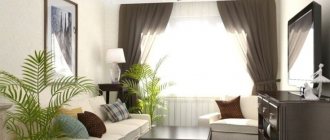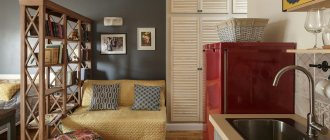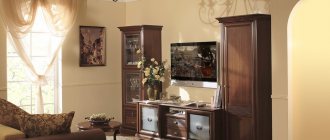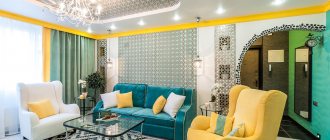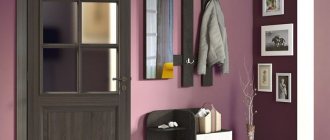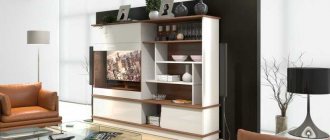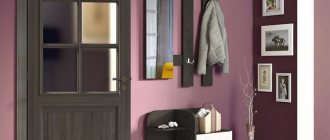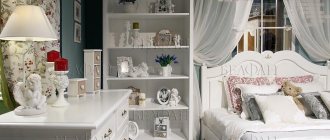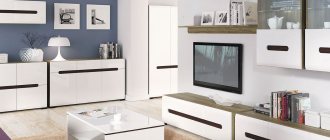When setting up a small living room, the most important thing is to arrange the furniture so that the room is functional and uncluttered. We present ready-made designs for the best arrangement of furniture in a small interior - perhaps they will inspire you to arrange a living room in your own apartment.
Furniture arrangement is one of the most important elements in your interior design, but it can also be one of the most confusing parts, especially if you're dealing with a complex room.
A small living room can be comfortable and functional if you plan the room layout well. The starting point for the arrangement should be living room furniture , first of all a sofa, and then armchairs, if any.
The sofa is usually the largest piece of furniture in a living room, so its placement will dictate where everything else is arranged. Most often we place it against the wall, but this is not the only solution.
How to arrange furniture correctly?
In an empty room, anything is possible. You can fill it with traditional, elegant wooden furniture, or with everyday essentials. Between these extremes lies a virtually endless range of possibilities, the number and variety of which can be daunting to the average homeowner.
A corner sofa is a good option for small interiors. This sofa allows you to make more efficient use of the space you have. It provides more seating space than a traditional sofa and allows you to turn around problem corners of the room. Thanks to this, we can create a comfortable seating area without the need to add additional chairs.
How to decorate a small living room? Practical tips for arranging a living room
* Avoid furniture from one set - the room will seem heavier. An eclectic combination of furniture will add lightness to the interior.
* Small pieces of furniture, such as chairs, poufs, bedside tables, look better when they are placed diagonally - at an angle. On the contrary, the main furniture (sofa, bookcase) is parallel to the walls.
* Width is more important than the length of furniture.
* Round coffee tables are better suited for small rectangular interiors. They are easier to arrange and add lightness to the interior.
* Strictly symmetrical furniture, especially at right angles, makes the interior more formal and the room heavier. Asymmetrical furniture arrangement is lighter.
Arranging a living room in a classic style
The classic design of the living room should be based on muted tones (warm colors) and furniture with round shapes. The colors you have when decorating are brown, beige and gray, and if you want to introduce additional ones, such as purple, green or red, let them be colors with a large admixture of gray or beige (looking as if they have faded due to exposure). sun rays).
Leisure furniture should have soft seats and backs, as well as armrests, which will additionally provide comfort. A wingback chair will go well with a classic living room decor (if there's enough space, add a footstool upholstered in the same color as the chair). The coffee table can be covered with an embroidered tablecloth or crocheted napkin. Decorate the windows with curtains that are attached to the side of the window with decorative ties. When it comes to lighting, a pendant lamp alone is not enough. It would be nice to add a floor stand in the corner of the room, a tabletop on the chest of drawers and sconces above the paintings on the walls. The materials that will appear in the design of the living room must be of high quality: solid wood (furniture), stone (window sills, fireplace trim), Persian carpets, etc.
A characteristic feature of a classic-style living room is also symmetry, which can be seen in the photo below. The axis of symmetry runs through the center of the room - at its end, against the wall, there is a TV stand, on both sides of it there are windows with books, dishes and decorative trinkets. Instead of one larger coffee table, we have two smaller ones, but this does not break the symmetry of the living room arrangement. The same is with living room furniture - on one side there is a small sofa, and on the other there are two armchairs, but the similar shape and the same upholstery make them almost identical at first glance.
Where it may seem like there isn't enough seating and extra space for guests for every member of the family, modular furniture is a great fit. A sofa, consisting of several independent parts, allows you to reorganize the space in the living room depending on your needs.
For example: when you have a lot of people, you can combine all the elements by extending a large sofa that will fit more people.
Once you have decided on the basic layout of your furniture arrangement , you can move on to decorations and additions. They can also make a big difference in how your living room looks. It is worth remembering here that the smaller the living room, the fewer decorative elements it should have, especially colorful ones.
A huge number of colors and shapes negatively affects the perception of space - then the interiors seem cluttered and overwhelming. The safest way is to use one or two colors . For example: In a living room with white walls and bright furniture, we place green plants and curtains in a floral pattern (floral motif) and brass lamps, photo frames or vases (brass motif).
Living room layout
Measure your living room from wall to wall, taking into account the length and width of the room.
First draw a diagram, noting measurements on all sides. Whether you create it in a computer program or draw it by hand on graph paper, a scale floor plan will be extremely useful for planning any kind of space. The easiest way to convert meters is on a scale of 1:2, where 1 m2 is equal to 2 notebook cells.
For example, a living room measuring 13 by 25 m2 will turn into a diagram measuring 26 by 50 notebook cells. Next, measure any furniture you decide to include and create a separate diagram with a unique size for each piece. If you're drawing by hand, I have an idea that involves creating mock-ups of paper furniture (to scale) by cutting it out of the paper so that it's easy to play with different furniture variations.
Determine the focal point
Deciding on a focal point will really help in planning the space - TV, fireplace, chandelier, artwork, etc. Once that is decided, the furniture pieces will fit around it.
Emphasis on the focal point of the space
If there is a TV in the living room, please note that the viewing distance of a standard TV is between 2.5 and 3.5 m and the viewing angle is no more than 30 degrees. Thus, the main sofa, daybed or sectional should be positioned against this wall. Additional armchairs and chaises can also be placed against either side of the TV wall, rounding out the seating area while adding visual balance.
Correct placement of furniture
For living rooms with a fireplace, the most important purpose, according to most people, is conversation. Thus, a semi-circular design of furniture around the hearth, with no more than 2.5 m between seats, promotes easy interaction with family and friends. For living rooms where there is neither a fireplace nor a TV, a central focal point makes the most sense. Place a sofa (or two, facing each other) around a coffee table, with chairs arranged in a circle to cover any gaps.
Arrange the table, wardrobe and sofa
Once the seating area is set (around the focal point), place the table and cabinet next to them. In the living room, the main coffee table or ottoman can be placed between the sofa and chairs. It's best to leave 50cm between the coffee table and the sofa so that drinks and the TV remote are within reach. The cabinet can be placed behind the sofa.
Wooden folding table
Be sure to leave at least 30cm between pieces of furniture in areas where people need to pass. For small spaces, consider folding tables that can fold out when in use and fold away when not in use. Storage cabinets and chests of drawers are placed against the wall where space allows.
Placing the cabinet where space allows
Media consoles and TV stands go under the TV, and a buffet is usually placed along the longest wall. Tall shelves and open cabinets that hold mementos, books, accessories and family photos look better on a larger, empty wall so it doesn't look crowded. Bar cabinets and carts are elements that add an aura of glamor to the living room.
Elegant trolley element
Consider floor and table lamps
Floor lamps take up part of the table, so a coffee table should be within reach for guests to place drinks. There are some floor lamp designs that come with an accompanying table.
Floor lamp for recreation area
Table lamps are self-explanatory—just make sure they don't take up the entire tabletop. Chandeliers should be concentrated above the main seating area. Recessed lights make sense anywhere on the ceiling since they don't droop. Spot lighting can draw attention to artwork, sculptures or a library.
Living room table lamp
Center your mat
The last element of living room furniture design is also the simplest: the rug. It should be centered in the middle of the main seating and extend a few inches under the sofa and armchairs (or even further) to anchor the entire room. If the room is already carpeted, adding a thicker accent rug on top is a great way to add warmth and encourage guests to relax and stay a while.
A rug in the living room for warmth and comfort
By following these simple steps to designing your living room furniture, you'll ensure that your space is a pleasant place to relax and flow into the rest of your home. Here are more questions to ask yourself:
- What do I want to see first when I walk into a room?
- what do I want to see on the walls - will there be an air conditioner or a radiator?
- will there be zones or dividers designed in the room?
Comfort zones in one large room
Basically, figure out what's most important to you before you start decorating or buying furniture, and you'll be able to create a special space that reflects your personal taste.
Make your dreams come true
Modern furniture arrangement in the living room
Arranging a living room in a modern style is the most successful solution due to the possibility of modifying the interior over time. What does this mean in practice? The modern style is most often based on furniture of simple shapes (often from the same collection) and a color palette consisting of 3-4 colors. It is enough to enrich such a composition with several decorations, textiles and wallpaper with an appropriate pattern to give the interior a completely different character. If you opt for white furniture, be sure to break up the sterility of that white color with other elements of the composition in bright colors or patterns.
Modern living room design is as much about furniture for storage as it is about furniture for relaxing, but you don't have to limit yourself to a sofa - you can make it up with armchairs, chaise lounges and daybeds. The last two pieces of furniture, which are still more associated with the palace style, also appear in a modern design and perfectly complement the relaxation area in the apartment.
Gray has been managing our apartments for several years. It came to us with the Scandinavian style and even if you don't decorate according to this trend, it still appears on the walls, upholstery and in the form of accessories. However, planning to decorate your living room entirely in this color (in different shades of this color) can be a little risky. Even if they are a warm gray color, the interior may seem gloomy and unfavorable for relaxation.
This can be easily changed by adding colorful pillows, curtains, carpet. What colors does gray go with? Almost all of them are combined with yellow, orange, red and turquoise to best effect. On the other hand, combinations with brown and black are best avoided, but you can afford accessories in black and white.
Do you like interiors full of patterns and colors? In the bedroom they need to be used with great care, but in the living room you can allow yourself a little madness. At first you will need just a few accessories in bright colors, then, step by step, you can add new patterns and colors until you achieve an effect that will fill the interior with positive energy.
Fans of a more relaxed living room design will definitely love the interiors filled with natural wood and plants. In such a living room, the walls are painted white, and against their background pots with monsteras, ferns and dracaenas are placed - on chests of drawers, shelves, flower beds, or even directly on the floor, if the plant is of a suitable size and is not covered by any furniture.
What is an online planner
The essence of online interior planners is that these programs allow you to draw a three-dimensional plan of an apartment, kitchen layout, virtually arrange furniture and see how it will look. They differ in the level of capabilities, but the basis is the same: the user selects a room layout, sets parameters - and can see a three-dimensional model.
Well, then you can add furniture.
Our opinion: - It’s also good that there are a lot of free planners (in some cases you need to register on the owner’s website, in some - not).
Simple Schedulers
The simplest planners create a flat drawing of a room, familiar to most of us from school drawing lessons.
This is the simplest option - an analogue of a drawing with a pen on paper; it is usually needed if the room has architectural elements of complex shape - fancy protrusions, niches, and so on, which are sometimes difficult to visualize on your fingers.
Volume planners
The second option is more interesting, it allows you to create a three-dimensional color model. You can set the dimensions of the furniture and rotate them: try several options for kitchen sets, rearrange items around the room in search of the best place for the bed.
You can change the color of the walls and floors, move partitions, move windows and doors (this is often required by those who are building their own house) or look for the most convenient place for the distribution panel.
Complex schedulers
But the most interesting option is “advanced” planners, which allow you to create a complete three-dimensional model of the room.
In them you can set not only the color and size, but almost everything: the shape of pieces of furniture, style, any decorative elements, etc. What the room will look like if you move the partition and put a sofa in the partition, red furniture in the kitchen, a green carpet, or, conversely, whether this wall should be painted a different color and, if so, what color - you can see all this.
Our opinion: - The resulting model can be seen from all sides, rotated and even watched like a movie if the program has a “virtual tour” function.
Planners from furniture manufacturers
A special place is occupied by planners from large manufacturers (furniture, windows, doors, partitions, and so on). On their websites you can set the parameters of your room, and then “arrange” your favorite furniture from the manufacturer’s catalog in it and see how it will look specifically in your case.
The most famous of these planners is from IKEA.
Complex layout
Planners can help in cases where the room has a complex, non-standard shape. It will also help when planning artificial “difficulties” - when creating a niche, a bay window or a complex suspended ceiling.
They come in handy in cases where you can’t choose a piece of furniture—a kitchen set, for example. The ability to look in such cases is an irreplaceable option.
General placement rules
Each room has its own functional purpose, location of window and door openings, dimensions and light sources. There are generally accepted universal rules on how to properly arrange furniture in a room:
- Before arranging furniture, you need to know the dimensions of the room and furniture structures. You can use graph paper and draw the area of the room to scale on it. And also prepare pictures of furniture on paper in compliance with proportions. Present the arranged furniture in the apartment on a prepared paper model;
- To properly organize the space, highlight the main element of the room. If this is a living room, then it could be a TV, a fireplace or a painting. In the bedroom, the central element is considered to be a sleeping place, and in the kitchen - a dining table;
- At what distance should furniture be placed from each other? The optimal distance between two objects is 1.8-2.4 m. A furnished room should be free for movement and harmonious;
- Corners are given special attention. In a narrow room or Khrushchev building, they are compactly filled with objects that will not attract attention to themselves. The corners can be filled with shelving, a small corner open or closed cabinet, or a floor vase can be placed in it;
- The sofa, table and chairs in the room are placed at a distance of 0.6-0.8 m from each other. An arm's length distance is comfortable for communicating or drinking tea with guests;
- To visually increase the space, it is recommended to hang paintings as high as possible. In a room where there are two windows on different walls, mirrors are installed. They will visually double the volume of the room and add light to the room;
- Place light, compact furniture in a narrow room, and hang thick curtains on the window openings. Do not clutter the shelves with photographs, souvenirs and other small items.
Arranging a nursery
Contrary to the conventional wisdom that a nursery should be cute first and foremost, I want to argue and say that this room should be functional and safe first and foremost. Think about what could be dangerous for your child and eliminate these things first. The stop list includes such things as:
- natural mirrors (replace them with special plastic ones intended for children);
- all kinds of sockets (insert blockers that you can buy at IKEA);
- handles from plastic windows that need to be pulled out, first adjusting the safe ventilation mode;
- insufficient lighting (place night lamps and other light sources).
Safe room for baby
Functionality
The functionality of a children's room is especially important for a baby in the first years of life - in this case, you should carefully consider night feeding and the trajectory of the mother's movement through all the obstacles that may be encountered along the way. A sufficient amount of light, a feeding area with a comfortable rocking chair next to the crib will make life calm not only for the mother, but also for the baby.
Multifunctional and comfortable children's room
Many experts recommend that you keep your baby's crib away from windows, as temperatures tend to be cooler near windows and there's also the risk of your baby tearing off blinds or curtains. Placing a baby crib near the interior wall of the house will be a warmer, calmer place and inaccessible from outside noise. Also make sure that any lamps or accessories are kept at a safe distance so that the child cannot remove them or they will not fall while he is sleeping.
Free space around the baby's crib
Of course, above all else, you want the children's room to look perfect and have the "wow" factor. The crib is the key focal point in a nursery and is the first thing people pay attention to. I recommend, if other factors allow, to place the crib somewhere where it can be seen in the doorway.
Placing the bed for mommy's comfort
There are several different options for crib placement, depending on the size of the room and the look you want. First of all, you can place it in the middle of the wall with the headboard against the wall. This is perhaps the most common location and allows for other pieces of furniture to be placed on both sides. In larger rooms, the crib can be placed in the middle of the room.
Place the crib as convenient for you
Much of the atmosphere that makes a nursery special comes from the accessories. A tasteful piece of art, a few pillows and a cute rug will be the icing on the cake in any child's decor, as long as the structure is in place. Add a couple of paper lanterns and a small potted flower.
Arrangement methods
How to arrange furniture in a room ─ this question interests many people. Exquisite and beautiful furniture can be arranged tastelessly, so that the furniture pieces do not match each other. There will be no harmony in the room. Let's consider the main universal ways of arranging furniture structures in a room:
- Symmetrical ─ this is a paired arrangement of furniture. A central place is selected and objects are placed at equal distances from it. The central place can be not only the center of the room, but also a corner or window, a picture or a TV. Furniture items should be small in size. In a square room, arranging objects in this way will create an ideal atmosphere. For example, place two identical chairs by the fireplace, and two small bedside tables on both sides of the bed. For a symmetrical arrangement, you need to use furniture of the same style;
- Circular ─ the center for this method is a table or chandelier. Furniture items from the central place stand in a circle. Here you can use furniture of different styles and decorative features. Circular arrangement of furniture is best used in large rooms. The main thing is that there is enough space between objects for free movement. This method is relevant in a room with semicircular walls.
The best and optimal option for placing furniture are rooms of the correct shape. But many designers have presented non-standard living room designs. They may have an irregular geometric shape ─ a fifth corner or a semicircular wall. In such rooms, corner furniture or furniture made according to individual projects comes to the rescue. And for a long room, you can use a cabinet or rack that is installed along a narrow place. The dining area can be equipped in the center of the living room or in the walls located between two windows. In large rooms, the science of Feng Shui will be useful in arranging furniture. How to arrange furniture using this teaching:
- Decorate the central part. Install large items ─ sofa, sofa, wardrobe, chest of drawers;
- To preserve positive energy in the room, you should not install racks, cabinets and other tall furniture near windows and doors;
- Sofas and chairs should not be placed with their backs to window and door openings. This blocks the entry of energy;
- For the living room, according to Feng Shui, round tables are used;
- It is better to install TV and video equipment near the western wall. Just not in front of window or door openings. To neutralize negative energy near the TV, you need to install a barrier of fresh flowers or plants;
- The living room is filled with positive QI energy by a fireplace, a low table and shelves with different collections of objects.
B. Small room
How to arrange furniture in a small two-room apartment? A small room is associated with a lack of usable space. But it can be furnished with neat small furniture in the chosen style direction. To arrange furniture in a small 15 sq. m room, use some tips:
- It is advisable to abandon the usual cabinet furniture. It can be replaced by a small wall-slide; An installed book-sofa will preserve free space and it will remain free in the center of the room;
- A small room of 10 meters can be divided into zones using bookshelves;
- Furniture should be multifunctional. For example, a coffee table can have shelves and niches with doors, a compact sofa with lower drawers for bedding turns into a comfortable sleeping place at night, and a wardrobe hides personal belongings and items;
- The furniture should not contain various decorative or carved elements. They visually reduce and weigh down the overall appearance of the room;
- The finished children's set, which consists of a bed, a wardrobe and a computer desk, should not have sharp corners. And there are numerous drawers for bedding, toys, and textbooks. How to arrange furniture in a room? Experts recommend installing it along walls or in corners;
- If several people live in the room, then installing a bunk bed against the wall will help save more free space for children to play and receive friends;
- You can use tables with adjustable heights, mobile bookshelves, a lift-up bed, and a retractable tabletop.
So, how to arrange furniture in a small room? First, a schematic representation of the arranged furniture is made on a sheet of paper.
B. Studio
In a 25 sq. m studio, the main thing is the correct zoning of the room and the selected lighting. It is very difficult to place all the necessary items for a comfortable stay in a small room. Today, many consumers use the services of furniture companies that manufacture custom-made furniture. This helps to save free space in the studio room:
- To highlight the living area with a bright decorative element, you can install a chest of drawers in which all household items will be stored;
- Design projects for studio rooms include sleeping places where blankets, pillows and bed linen are hidden at the headboards. And all household utensils are stored in compact kitchen cabinets;
- You can use folding tables and chairs, which are stored in the closet and taken out when guests arrive. To visually increase the space in the studio room and reflect more light, it is advisable to use glossy or mirrored facades in cabinets;
- Zoning a room can be done by installing a bookcase or bedside table, or using a headboard and sliding partitions. The living area will have shelves for books and other small items;
- For long-term storage of seasonal items, hanging mezzanines are provided;
- A bench or banquette can be installed in the entrance area. They are designed not only for comfortable putting on shoes, but also for storing them.
Zoning options
Today, new and old residential premises are decorated in the American loft style. It combines on one territory, even in a room of 17 meters, several functional areas ─ bedroom, living room, dining room, office. The style is relevant and truly works in the design of modern interiors.
No matter how many zones there are in one room, they are united by the total area and style of the room. All kinds of decorative and furniture elements are used for separation; there are 20 meters in a room, photos of which can be viewed on the pages of Internet resources; it is good to use screens, podiums and other elements.
Furniture creates harmony and comfort in the design of the area. And the style direction is emphasized by the color direction of the decorating elements.
For zoning the following are used:
- Partitions (mobile or stationary);
- Arches;
- Shelving;
- Cabinets;
- Screens;
- Curtains.
Factors such as color scheme, finishing materials, decorative elements, different heights in the room and furniture arrangement take part in the zonal delineation. Furniture stand structures are also an effective element for zoning a room. The way furniture is arranged in the house affects zoning:
- Cabinets are used to divide space;
- Modular blocks are transformed to form different geometric designs. This new design solution can adequately divide a room of 16 sq. m. Block elements can turn into a modular design ─ wardrobe, cabinets, chest of drawers and fit perfectly into the interior of the room;
- Mobile and lightweight screens are installed to delimit zones in small rooms, and partitions in large ones.
By correctly zoning the room, we will get a visually enlarged aesthetic space. You can use innovative technologies. To do this, designers recommend using computer programs that will help you see the entire process of creating zones from any angle and angle. The created sketch will help in arranging furniture structures and will protect you from technical errors.
What furniture is suitable for a narrow and long bedroom
A comfortable atmosphere for sleep and relaxation is created not only thanks to the decoration, but also to the correct selection of furniture and proper arrangement. In the design of a small narrow bedroom, the presence of free space is very important. An excellent solution is built-in furniture in light shades; transformable models are welcome. The best option is a minimum of furniture. Only the most necessary and multifunctional.
For a narrow room, you should select compact furniture based on the available space
The mirror can be perfectly located at the head of the bed and its width should be no less than its width. Such a presentation will make the room almost twice as large and it will seem that the bed is not against the wall, but in the center of the room.
A folding bed is a godsend for a narrow bedroom that needs to accommodate several functional areas
By moving the sleeping area to a special podium, a long narrow bedroom will seem more spacious. It is necessary to make maximum use of the corner space to smooth out the configuration of the room. Decorative elements also help: paintings in square frames, panels, rugs and more.
How to arrange furniture in a room of 18 meters?
It is thanks to the different options for furnishing your home that you can create a unique and cozy atmosphere in it. To understand how to arrange furniture in a room of 18 meters, a photo will help you, among which there are many beautiful options, but adapting them to your home is not easy. To understand exactly how to proceed, you need to take into account several nuances: the shape of the room, its purpose and the possibility of zoning. If you follow the rules for placing furniture, you will be able to create a free and comfortable environment.
Bedroom
For a convenient and correct arrangement of furniture in the bedroom, you need to focus on the placement and features of the bed. First of all, you need to place it so that when you get out of bed, all other pieces of furniture are at hand. If the bed is designed for two people, then we must install two bedside tables on the sides. If there is a workplace in the bedroom, then you do not need to focus on the placement of the bed. Here it is best to choose a place where there is a lot of natural and artificial light.
Arrangement methods
The symmetrical option is one of the most common. There is no need to invent anything - just paired things are installed on the sides of a certain object or relative to an imaginary axis. Alternatively, armchairs near a coffee table or fireplace. In the case of diagonal symmetry, objects are located in opposite corners of the room. Moreover, it is not necessary to use the same elements. Chairs of different colors look original and unusual. It is in rooms of regular shape that it is most interesting to use this method of arranging objects.
The asymmetrical option involves placing elements near a specific focal center (window, door, fireplace). To create balance, the size of objects and their “weight” in the interior are taken into account. Therefore, the large item is placed closer to the center, and the small item further away. An asymmetrical setting can also visually correct the proportions of the room. And you definitely need to imagine how the composition will look from different angles. After all, if you slightly unfold a large sofa, you will be able to visually reduce its length and “weight”.
With the circular principle, things are installed at the same distance from a certain center. If there is a round carpet in the middle of the room, then it can be “outlined” with pieces of furniture (chairs, tables, sofas). The most popular centers are tables and lamps/chandeliers. Typically, rooms combine different types of arrangement of objects. For example, circular and asymmetrical or circular and symmetrical.
Placing furniture in the guest room
Typically, the living room is the largest room in the house. In a square-shaped room, along the entire length of the wall, you can place a wardrobe or a wall, opposite which you can place a corner sofa model. The main thing is not to place furniture with wood elements near radiators, as heat negatively affects the condition of the wood.
If there is sufficient space, the furniture in the hall also includes a coffee table in tandem with a pair of armchairs. It is advisable to hang the TV on the wall opposite the sofa or on a cabinet in the corner of the room.
What are the features of 18 sq m
A room of this size cannot be clearly considered large or small. Therefore, the location and number of pieces of furniture are determined by its layout, shape and purpose:
- In a walk-through room, it is not recommended to place objects on the lines of movement, otherwise injuries and damage to things cannot be avoided;
- If the room combines several functions, then individual furniture elements (shelves) can easily serve as partitions. It would also be a great idea to purchase transformable furniture (sofa bed, folding tables and chairs);
- In a room for a specific purpose (bedroom, living room, children's room), it is important to take into account its shape;
- If the room is too elongated, then installing a massive cabinet against one narrow wall will help visually adjust the proportions;
- In a square room, it is easier to focus on the center: a table with chairs is placed in the middle, and all other furniture is placed along the walls. Or place the main piece of furniture against one wall. Then other things are placed along the remaining three walls, with the largest element being placed opposite the significant one. For example, in the living room a sofa with armchairs is placed opposite the fireplace.
With any method of placing furniture, it is important not to clutter the area and make maximum use of “dead” zones (corners, bay windows, niches).
Arrangement options
If you start from the purpose of the room, it will be easier to decide how to correctly arrange individual pieces of furniture.
Living room
Most often, it is a housing center that unites all household members. And when arranging furniture, you can focus on the following priorities: functionality, geometry:
- It is good to use the functional principle when moving or in case of updating the situation, so as not to purchase unnecessary things. If the whole family likes to watch movies and TV shows together, then a soft area is set up opposite the wall with a TV. An excellent option is to install racks for books or souvenirs symmetrically on the sides of the equipment. If the owners often receive guests, then it makes sense to distinguish visually different zones in a living room of eighteen square meters. A round table with chairs will visually define the dining group. And with a corner sofa you can easily designate a relaxation area;
- Having chosen a geometric method of arranging furniture, it is important to maintain a balance between individual interior items. The best option is to place furniture along the wall. This saves more free space. It should be taken into account that the sizes of objects should fit organically into the parameters of the room. Paired items (chairs, tables) or objects that are symmetrical in height (shelves, cabinets) give the room a calm and harmonious look. And the asymmetrical arrangement of furniture will give the environment visual dynamics.
Kitchen furniture
The kitchen is the most difficult place to arrange furniture, since the room is often small in size. The ideal option is to arrange the kitchen unit in the letter “L”. This solution will make the room much more practical and compact. At the same time, there will be enough free space in the kitchen. C-shaped furniture arrangement is used only for large kitchens or irregularly shaped rooms.
Related article: Soundproofing of premises: review of materials
